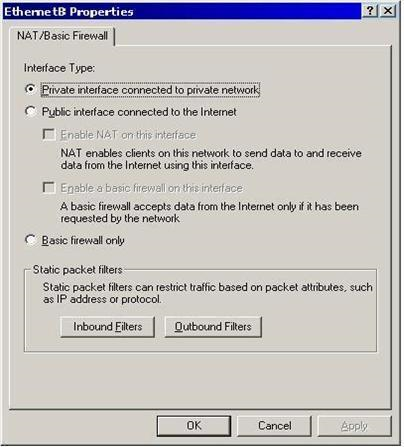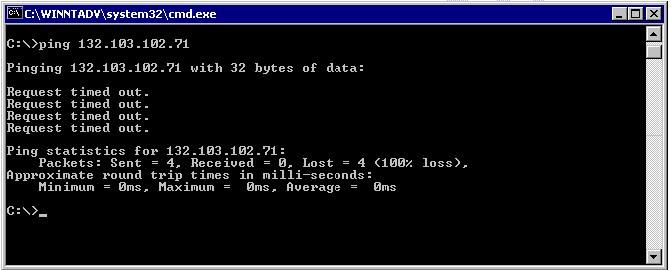Download Juniper Networks Certified Internet Expert (JNCIE-SP).JPR-961.VCEplus.2021-06-25.65q.vcex
| Vendor: | Juniper |
| Exam Code: | JPR-961 |
| Exam Name: | Juniper Networks Certified Internet Expert (JNCIE-SP) |
| Date: | Jun 25, 2021 |
| File Size: | 765 KB |
How to open VCEX files?
Files with VCEX extension can be opened by ProfExam Simulator.
Discount: 20%
Demo Questions
Question 1
You have recently added a Windows Server Web Edition system to your company's private network.
The server is used to host the company's private Web site. Users are complaining that response time is often slow. You want to analyze the traffic coming to and from the Web server. What should you do?
- Open Task Manager and use the Networking tab to gather network statistics.
- Open System Monitor to capture and analyze network traffic.
- Open Network Diagnostics to analyze the traffic coming to and from the Web server.
- Install Network Monitor on the Web server to capture and analyze network traffic.
Correct answer: D
Question 2
You administer a Windows Server Active Directory domain for your company. The domain is divided into two subnets. Subnet A uses the network address 192.168.12.0/24, and Subnet B uses the network address 192.168.14.0/24. All domain controllers and member servers are Windows Server computers, and all clients are Windows 2000 Professional computers.
Clients in Subnet A obtain TCP/IP settings from a DHCP server named DHCPA, which resides in Subnet A. Clients in Subnet B cannot obtain DHCP settings at all, even though you configured a scope for Subnet B on DHCPA. Your need to enable clients on SubnetB to automatically obtain TCP/IP settings from DHCPA. What should you install on Subnet B?
- a primary DNS server
- an SUS server
- a DHCP relay agent
- a master DNS server
- an SMTP server
Correct answer: C
Question 3
You administer your company's network. A single-domain Active Directory forest is configured on the network. All servers run Windows Server.
The network contains a server named Server5 that hosts confidential business datA. Access to Server5 must be restricted to only a few authorized personnel.
You must ensure that those users, including designated Server5 administrators,cannot share Server5's desktop with other users. What should you do?
- Disable Remote Assistance in the local policy on Server5.
- Create a new OU, move Server5 to the OU, create a GPO that disables Remote Assistance, and link the GPO to the OU.
- Create a new OU, move Server5 to the OU, create a GPO that disables Remote Desktop, and link the GPO to the OU.
- Disable Remote Desktop in the local policy on Server5.
- Disable Remote Assistance in System Properties on Server5.
- Disable Remote Desktop in System Properties on Server5.
Correct answer: B
Question 4
You are the security administrator for your company. The company's network supports 500 users. All network server computers run Windows Server.
All network client computers run Windows XP Professional. All domain account logon events are audited.
A human resources manager requests that you produce a listing of the times and dates a user named JohnP logged on to the domain.
The user was assigned to a client computer named HR09.
You should achieve this objective while reviewing the minimum amount of information.
What should you do? (Choose two. Each correct answer presents part of the solution.)
- Create a filter that will list all events for the JohnP user account.
- Use the Find option to list only the events for the JohnP user account.
- Open Event Viewer and access the security log on each domain controller.
- Use the Find option to list only the events for the HR09 computer account.
- Create a filter that will list only the events for the HR09 computer account.
- Log onto HR09 as a local administrator, and open Event Viewer to view the local security log.
Correct answer: AC
Question 5
You are the DNS administrator for TXGlobal, which is headquartered in Dallas and has branch offices in Austin, Houston, San Antonio and El Paso.
The headquarters location hosts the parent domain, txglobal.com. Each branch office has been delegated a child domain.
Austin hosts austin.txglobal.com, Houston hosts houston.txglobal.com, San Antonio hosts sanantonio.txglobal.com, and El Paso hosts elpaso.txglobal.com.
The primary DNS server in Dallas is named TXDNS. The primary DNS servers in the branch offices are named AUSDNS, HOUDNS, SADNS and EPDNS.
The secondary DNS servers in the branch offices are named AUSDNS-2, HOUDNS2,SADNS-2, and EPDNS-2.
To increase fault tolerance, you want to add another secondary DNS server in each location.
The new DNS servers will be named AUSDNS-3, HOUDNS-3, SADNS-3, and EPDNS-3. You want TXDNS to be aware that the new servers are authoritative for their respective zones.
Which server or servers should host one or more stub zones?
- AUSDNS, HOUDNS, SADNS and EPDNS
- AUSDNS-3, HOUDNS-3, SADNS-3 and EPDNS-3
- all of the DNS servers within the child domains
- TXDNS
Correct answer: D
Question 6
You are a network administrator for your company. The company network consists of two Active Directory forests.
Verigon.com is the single-domain forest that contains all user accounts and resources for the corporate network, except the resources that are allocated to the Development department. Dev.corp is the single-domain forest that is used only by the Development department. You configure an external trust between the two domains.
Developers must be able to log on from their computers to the verigon.com domain. In the verigon.com forest, you create a new user principal name (UPN) suffix of dev.corp and configure UPNs for the developers' user accounts in the verigon.com domain with this suffix. Developers report that they cannot log on to the verigon.com domain from their computers, which belong to the dev.corp domain, by using their UPNs. You must enable developers to log on to the verigon.com domain from their computers by using UPNs.
What should you do?
- Replace the external trust with a forest trust.
- Change the UPN suffix for the developers' user accounts to verigon.com.
- Configure selective authentication on the trust.
- Configure domain-wide authentication on the trust.
Correct answer: A
Question 7
You are the administrator for your company's network. Your company's logical network design consists of a single Active Directory domain.
All servers have the Windows Server operating system installed. All client computers run Windows XP Professional.
Woody is the manager for the company. He uses his client computer to read and edit large documents from the publishing department.
The computer is configured with a single basic disk consisting of two partitions. One partition is used as the boot and system partition.
The other partition hosts user data folders. Both partitions are formatted using NTFS.
The user data partition contains shared folders and files that use both share and NTFS permissions to grant access to employees in the editorial department.
Woody informs you that his computer is beginning to perform at a speed that is moderately slower than other client computers in the editorial department.
You use System Monitor and discover that a disk bottleneck exists.
How can Woody improve performance on this computer?
- Defragment the hard disk.
- Reformat the data partition using FAT32.
- Convert the hard disk to a dynamic disk.
- Delete the two existing partitions on the hard disk, and create a single partition.
Correct answer: A
Question 8
You are your company's network administrator. The network consists of a single subnet. All servers run Windows Server.
The network is connected to the Internet through a private WAN link. A computer named Server1 provides Internet access for the network.
Server1 is equipped with two NICs, and Internet Connection Sharing (ICS) is enabled on the NIC that is connected to the Internet.
Your company employs several telecommuters who work from their homes.
The remote employees require some files that contain information about the company's business operations.
Those files are updated on a daily basis. To provide the remote employees with those files, you set up an FTP site on a computer named FTPSrv.
You must ensure that the users on the corporate network can access Internet Web sites and that the remote employees can download the necessary files from FTPSrv.
The corporate network must be protected against possible Internetbased attacks. Access to the corporate network from the Internet must be restricted to only the FTP site on FTPSrv.
What should you do?
- On FTPSrv, enable Internet Connection Firewall, and specify that FTP traffic be allowed to pass to FTPSrv.
- On Server1, enable Internet Connection Firewall, and specify that FTP traffic be allowed to pass to FTPSrv.
- Configure Server1 to use IPSec for all communications on the NIC that is connected to the Internet.
- On Server1, enable Internet Connection Firewall, and configure it to allow only HTTP and FTP traffic to pass to the corporate network.
Correct answer: B
Question 9
Mark works as a Network Administrator for ABC.com. The company has a Windows single domain-based Active Directory network.
The network has five Windows member servers and 200 Windows XP Professional client computers. The network has a Windows Server that works as a DNS server.
The DNS server contains the following types of resource records:
- Name Server (NS) resource record
- A resource record
- PTR resource record
- SRV resource record
- MX resource record
Mark updates the A resource record. Which of the following types of resource records can be associated with the A resource record and needs to be updated?
- The associated PTR resource record needs to be updated.
- The associated SRV resource record needs to be updated.
- The associated MX resource record needs to be updated.
- The associated NS resource record needs to be updated.
Correct answer: A
Question 10
Andrew works as a Network Administrator for ABC.com. The company has a Windows domain-based network. The company has two Windows servers and 150 Windows Professional client computers. The company has a Windows server named NATSERV that has a dial-up connection to the Internet.
NATSERV has two network interfaces named EthernetA and EthernetB .
EthernetA is connected to the LAN and has an IP address of 192.168.1.121. EthernetB is connected to the Internet and has an IP address of 132.103.102.71.
The client computers on the LAN connect to the Internet by using NATSERV. NAT also has Routing and Remote Access installed.
Andrew enables the NAT/Basic Firewall routing protocol on NATSERV.
The configuration of the NAT/Basic Firewall routing on NATSERV is shown in the image below:


The client computers on the network are unable to connect to the Internet.
When Andrew tries to ping 132.103.102.71 from the client computers on the local network, he receives a message as shown in the image below:

Andrew wants to ensure that the client computers on the local network are able to connect to the Internet.
What will he do to accomplish this?
Each correct answer represents a part of the solution. (Choose two.)
- For EthernetB, configure Outbound Filters under Static packet filters.
- For EthernetA, configure Inbound Filters under Static packet filters.
- For EthernetA, configure NAT/Basic Firewall as 'Private interface connected to private network'.
- For EthernetB, configure NAT/Basic Firewall as 'Public interface connected to the Internet'.
Correct answer: CD
Explanation:
HOW TO OPEN VCE FILES
Use VCE Exam Simulator to open VCE files

HOW TO OPEN VCEX AND EXAM FILES
Use ProfExam Simulator to open VCEX and EXAM files


ProfExam at a 20% markdown
You have the opportunity to purchase ProfExam at a 20% reduced price
Get Now!



